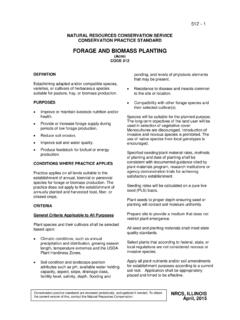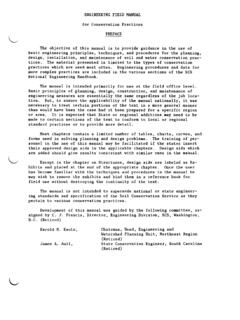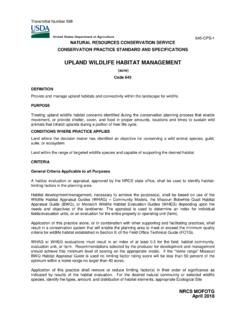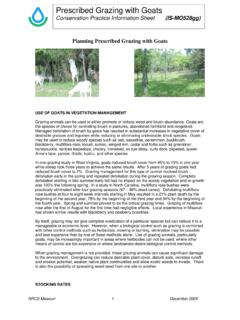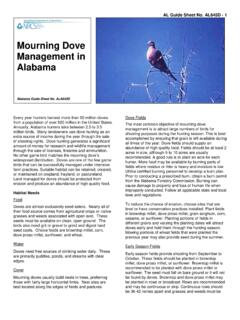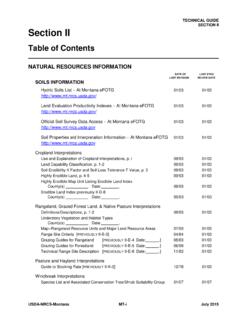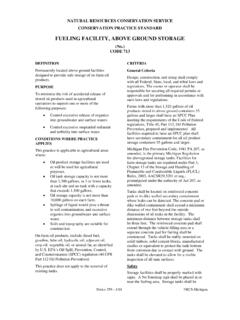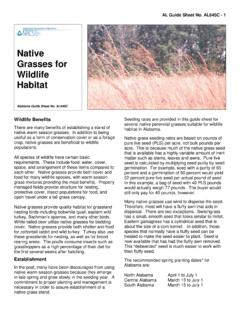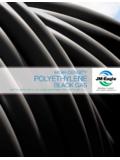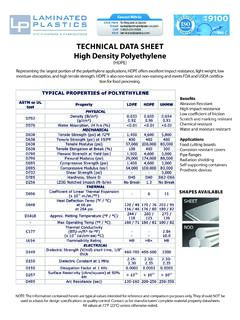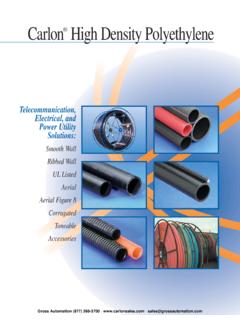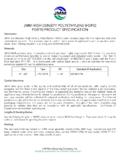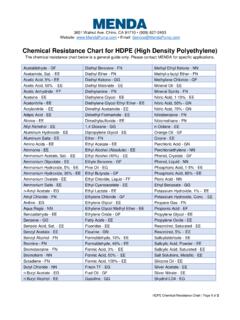Transcription of ABOVE-GROUND HIGH DENSITY POLYETHYLENE (HDPE) PIPE
1 TECHNICAL NOTES DEPARTMENT OF AGRICULTURE NATURAL RESOURCES CONSERVATION SERVICE ENGINEERING # 12 SPOKANE, WASHINGTON January 2009 ABOVE-GROUND HIGH DENSITY POLYETHYLENE (HDPE) PIPE BACKGROUND Occasionally, we work on projects that require pipe to be laid out across the prevailing terrain. The pipe may simply be placed on the ground surface, or it may be suspended or cradled in support structures. Above ground installations may be desired due to the economic considerations of a temporary piping system, the presence of rock and the cost for blasting a trench, land rights, cultural resources, or an easement that prevents burial of the pipe.
2 POLYETHYLENE (PE) pipe provides good joint integrity, toughness, flexibility, and low weight to make its use practical for many above ground applications. This technical note presents design criteria and prevailing engineering methods that are recommended by The Plastic Pipe Institute for ABOVE-GROUND installation of POLYETHYLENE (PE) pipe. This technical note will discuss the effects of temperature extremes, chemical exposure, ultraviolet radiation and potential mechanical impact or loading. Engineering design considerations for both on grade and suspended, or cradled, POLYETHYLENE pipe installations are also discussed.
3 DESIGN CRITERIA An Excel spreadsheet has been developed to assist with the commutations and analysis. The spreadsheet is located on the WA state engineering webpage. The design criteria that can influence the behavior of PE pipe installed above ground include: Temperature Chemical resistance Ultraviolet exposure Potential mechanical impact or loading Fire damage Temperature Above ground pipe installations are exposed to wide fluctuations in temperature. By contrast a buried installation has temperatures that are usually relatively stable. There are three main types of temperature changes that affect any piping material installed above the ground.
4 These changes are: irradiation by the sunlight, seasonal temperature extremes, and day to night temperature changes. As a rule, POLYETHYLENE pipe can be used safely at temperatures as low as -70 oF and as Engineering Technical Note #12 ABOVE GROUND HDPE PIPE January 2009 Page 2 of 11 high as 150 oF. However, temperature does affect the engineering properties of POLYETHYLENE pipe. Pressure capability of POLYETHYLENE pipe is predicated on the long-term hydrostatic strength (LTHS) of the polymer used in its manufacture. The LTHS decreases as much as 50% as the temperature to which the PE pipe is exposed increases.
5 Correspondingly, the pressure rating of a specific pipe is increased as much as 150% as the service temperature decreases. Information regarding the temperature responsive nature of a specific PE pipe is available from the respective pipe manufacturer. Chemical Resistance POLYETHYLENE pipe will not rust, rot, pit or corrode because of chemical, electronic or galvanic action. The only chemical environments that pose potentially serious problems for POLYETHYLENE pipe are strong oxidizing agents and certain hydrocarbons. Concentrated sulphuric and nitric acids are strong oxidizers while diesel and fuel oils typify the hydrocarbons.
6 Environments that contain oxidizing agents may affect the performance characteristics of PE pipe. The continued exposure of POLYETHYLENE to strong oxidizing agents may lead to crack formations or a crazing of the pipe surface. Usually, occasional or intermittent exposure to these agents will not significantly affect the long-term performance of a PE pipe. Ultraviolet Exposure POLYETHYLENE pipe utilized outdoors in above ground applications is subjected to extended periods of direct sunlight. The ultraviolet component in sunlight can produce a deleterious effect on the pipe unless the material is sufficiently protected.
7 POLYETHYLENE pipe produced with a minimum of 2% concentration of finely divided and evenly dispersed carbon black is protected from the harmful effects of UV radiation. Mechanical Impact or Loading Any piping material that is installed in an exposed location is subject to the rigors of the surrounding environment. It can be damaged by the movement of vehicles or other equipment, and such damage generally results in gouging, deflecting or flattening of the pipe surfaces. If an above ground installation must be located in a region of high traffic or excessive mechanical abuse, the pipe requires extra protection.
8 The PE pipe may be protected by building a berm or by encasing the pipe where damage is most likely. Design criteria for the installation of buried flexible thermoplastic pipe should be used for those areas where the above ground PE system must pass under a roadway or other access and/or where an underground installation of a portion of the system is necessary. In general, in an installation in which any section of PE pipe has been gouged in excess of 10% of the minimum wall thickness, the gouged portion should be removed. When the PE pipe has been excessively or repeatedly deflected or flattened, it may exhibit stress-whitening, crazing or cracking, or other visible damage.
9 Any such regions should be removed and replaced with new pipe material. Fire Damage Engineering Technical Note #12 ABOVE GROUND HDPE PIPE January 2009 Page 3 of 11 A major consideration for the use of above ground PE pipe is the potential damage from fire. PE materials will sag, deform, and/or burn when subjected to high temperatures associated with fire. The potential for wildfire along the path of any above ground pipe installation needs to be addressed in the operation and maintenance plan. Items may include the use of fire retardant vegetation along the pipeline route and established fire breaks.
10 DESIGN METHOD: ALLOWABLE DESIGN PRESSURE The exposure of above ground pipe to sunlight can result in extremely high outside surface temperatures. In the majority of cases, the water flowing in the pipe is substantially cooler than the exterior of the exposed above ground pipe and water flowing through the pipe tends to moderate the surface temperature of the exposed pipe. This can result in a pipe wall temperature that is only slightly above the temperature of the water flowing through the pipe. However, in pipeline systems with occasional flow, the temperature increase can be much higher.

